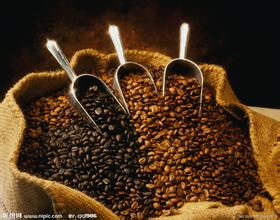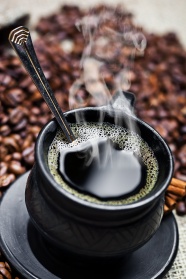Java in Cameroon introduces the shape of coffee beans.
Abstract: Cameroon has the characteristics of soil quality, climate and topography, which is suitable for the growth of many kinds of crops. The main crops are coffee, cocoa, cotton and other cash crops and millet, sorghum, corn and other food crops. Cameroon is rich in Rob Coffee Raw beans.

Cameroon has the characteristics of soil quality, climate and topography, which is suitable for the growth of many kinds of crops. The main crops are coffee, cocoa, cotton and other cash crops and millet, sorghum, corn and other food crops. Cameroon is rich in Rob Coffee Raw beans.
Rich volcanic soil, high altitude, moderate rainfall-all of these make Cameroon an ideal place to grow good coffee and is the main producer of world-famous premium coffee. Cameroon coffee has a mellow, earthy, chocolate-flavored silhouette and a plump polish with hints of red berries. The quality and characteristics of Cameroon coffee is similar to that of coffee from South America. Flavor: the palate is rich and soft, with low acidity. The products are graded according to the particle size, and the order from large to small is GG,G1,G2,G3,G4.
The Cameroon Capulami Cooperative, founded in 1958, learned coffee cultivation techniques and grown this excellent Jiawa coffee from coffee experts in Kenya, Tanzania and Rwanda; Cameroon's total export volume of coffee is equivalent to 1.5 million bags. Of these, 80% are Robbda seeds, and 20% Arabica coffee is mainly exported to Germany and France. The Arabica species of Cameroon was introduced by the Germans in 1905. Its provenance is said to be the same as Java coffee and Blue Mountain coffee. To be sure, it is the former Arabica coffee grown in an agricultural proving ground called Dschang. In the western highlands, it has spread widely in the surrounding areas because farmers use tin cards.
But Cameroon's coffee industry collapsed from the second half of the 1980s to the mid-1990s, when falling coffee prices and the abolition of zhengfu agricultural aid led farmers to give up growing coffee, a state that lasted for about a decade. Farmers have resumed the cultivation of coffee as a sustainable crop, and coffee production has been gradually restored by pure natural farming without the assistance of zhengfu.
2. Introduction of beans
Merchant name
Capra Mijiawa (java) long shaped bean
Country of birth
Cameroon
Terrestrial domain
Puffo Wusam, South West
Those who give birth
Capulami production cooperative
Missing point specification
There is no formulated specification, usually 30 defects / 300 grams
Size specification
More than 16 mesh
Equal grade
Special essence
Coffee tree variety
Java species
Flowering period
April to May
Harvest period
September to December
Its it
Elevation 1200-1800 meters, processing method: 100% sun after washing. The annual output of Jiawa coffee is only 2 containers.
Cameroon Java long bean
[original name]: Cameroon UCca* Caplami Java
[variety]: Java Java Arabica species
[growth altitude]: 5000 ft
[raw bean treatment]: half-washed Semi-Washed Process
[Origin]: West Africa-Western Cameroon Plateau
[producing areas / manors / cooperatives]: UCca* Caplami Cooperative
[label]: UCca* Caplami Cooperative
[grade]: Grade 1
[appearance]: 18 screen long beans
Third, Mr. Kenneth Davids's cup test report:

Fourth, photo description: coffee harvest scenery printed on 1962 coins.

Java is a kind of long bean.

Bask in the field

Sorting

Loading
Important Notice :
前街咖啡 FrontStreet Coffee has moved to new addredd:
FrontStreet Coffee Address: 315,Donghua East Road,GuangZhou
Tel:020 38364473
- Prev

Indonesia Kopi Luwak price boutique Kopi Luwak how much is cat shit coffee bean characteristic story
Kopi Luwak is made in Indonesia. In the early 18th century, the Dutch established coffee plantations in the Indonesian colonies of Sumatra and Java, and banned locals from picking and eating their own coffee fruits. Indonesian locals inadvertently found that civets love to eat these coffee fruits and will drain the beans intact when defecating. The civet can only pick the most familiar.
- Next

The characteristics of Guatemalan coffee the price of Guatemalan coffee the taste of Guatemalan coffee
A cup of Antigua coffee in Guatemala seems to let us see the sudden disappearance of the mysterious Mayans multiply in the ancient land, history brushed away their existence, history has achieved their eternity. If a person's wrinkles depict a person's path, then the smell of coffee remembers the origin of a cup of coffee: about its hometown, harvest time, baking and research.
Related
- Does Rose Summer choose Blue, Green or Red? Detailed explanation of Rose Summer Coffee plots and Classification in Panamanian Jade Manor
- What is the difference between the origin, producing area, processing plant, cooperative and manor of coffee beans?
- How fine does the espresso powder fit? how to grind the espresso?
- Sca coffee roasting degree color card coffee roasting degree 8 roasting color values what do you mean?
- The practice of lattes: how to make lattes at home
- Introduction to Indonesian Fine Coffee beans-- Java Coffee producing area of Indonesian Arabica Coffee
- How much will the flavor of light and medium roasted rose summer be expressed? What baking level is rose summer suitable for?
- Introduction to the characteristics of washing, sun-drying or wet-planing coffee commonly used in Mantenin, Indonesia
- Price characteristics of Arabica Coffee Bean Starbucks introduction to Manning Coffee Bean Taste producing area Variety Manor
- What is the authentic Yega flavor? What are the flavor characteristics of the really excellent Yejasuffi coffee beans?

